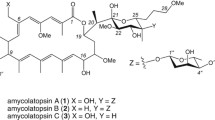Abstract
Chemical analysis of the crude extract of bacterial strain Bacillus amyloliquefaciens ELI149, which had been previously isolated from soil, resulted in the isolation and characterization of two known macrolactin derivatives, macrolactin A (1) and 7-O-succinyl macrolactin A (2). The structures of two compounds were assigned by 1D/2D NMR techniques. The two compounds were demonstrated antifungal activity against some important phytopathogens. However, the presence of the succinyl moiety at C-7 gives to the molecule more activity being the second compound more active than the first, showing for the first time, a structure/activity relationship. The cellular damage was also studied in two important phytopathogen fungi.



Similar content being viewed by others
References
Sansinenea E (2019) Bacillus spp.: as plant-growth promoting bacteria. In: Singh HB, Keswani C, Reddy MS, Sansinenea E, Garcia-Estrada C (eds) Secondary metabolites of plant growth-promoting rhizomicroorganisms. Springer-Nature, Singapore. https://doi.org/10.1007/978-981-13-5862-3_11
Keswani C, Singh HB, Hermosa R, García-Estrada C, Caradus J, He Y-W, Mezaache-Aichour S, Glare TR, Borriss R, Vinale F, Sansinenea E (2019) Antimicrobial secondary metabolites from agriculturally important fungi as next biocontrol agents. Appl Microbiol Biotechnol 103:9287–9303
Keswani C, Singh HB, García-Estrada C, Caradus J, He Y-W, Mezaache-Aichour S, Glare TR, Borriss R, Sansinenea E (2020) Antimicrobial secondary metabolites from agriculturally important bacteria as next biocontrol agents. Appl Microbiol Biotechnol 104:1013–1034
Ortiz A, Sansinenea E (2020) Macrolactin antibiotics: amazing natural products. Mini Rev Med Chem 20:584–600
Chakraborty K, Thilakan B, Raola VK (2014) Polyketide family of novel antibacterial 7-O-methyl-5′-hydroxy-3′-heptenoate-macrolactin from seaweed-associated Bacillus subtilis MTCC 10403. J Agric Food Chem 62:12194–12208
Romero-Tabarez M, Jansen R, Sylla M, Lünsdorf H, Häuβler S, Santosa DA, Timmis KN, Molinari G (2006) 7-O-Malonyl Macrolactin A, a new macrolactin antibiotic from Bacillus subtilis active against methicillin-resistant Staphylococcus aureus, vancomycin-resistant Enterococci, and a small-colony variant of Burkholderia cepacia. Antimicrob Agents Chemother 50:1701–1709
Elkahoui S, Abdel rahim H, Tabbene O, Shaaban M, Limam F, Laatsch H (2013) Cyclo-(His, Leu): a new microbial diketopiperazine from a terrestrial Bacillus subtilis strain B38. Nat Prod Res 27:108–116
Li W, Tang X-X, Yan X, Wu Z, Yi Z-W, Fang M-J, Su X, Qiu Y-K (2016) A new macrolactin antibiotic from deep sea-derived bacteria Bacillus subtilis B5. Nat Prod Res 30:2777–2782
Salazar F, Ortiz A, Sansinenea E (2017) Characterization of two novel bacteriocin-like substances produced by Bacillus amyloliquefaciens ELI149 with broad spectrum antimicrobial activity. J Glob Antimicrob Resist 11:177–182
Sansinenea E, Vaca J, Rojas NE, Vázquez C (2020) A wide spectrum of antibacterial activity of secondary metabolites from Bacillus amyloliquefaciens ELI149. Biosci J 36:235–244
Cuervo-Parra JA, Sanchez-Lopez V, Ramirez-Suero M, Ramirez-Lepe M (2011) Morphological and molecular characterization of Moniliophthora roreri causal agent of frosty pod rot of cocoa tree in Tabasco, Mexico. Plant Pathol J 10:122–127
Riddell RW (1950) Permanent stained mycological preparations obtained by slide culture. Mycologia 42:265–270
Olishevska S, Nickzad A, Déziel E (2019) Bacillus and Paenibacillus secreted polyketides and peptides involved in controlling human and plant pathogens. Appl Microbiol Biotechnol 103:1189–1215
Acknowledgements
The project was supported by VIEP (Vicerrectoria de Investigación y Estudios de Posgrado-BUAP) and CONACyT (Consejo Nacional de Ciencia y Tecnología) (N°251512).
Author information
Authors and Affiliations
Contributions
FS executed the experiments; AO and ES conceived and designed the project, carried out the analyses of NMR spectra and wrote the paper. All authors have approved the manuscript.
Corresponding author
Ethics declarations
Conflict of interest
The authors declare no conflict of interest.
Additional information
Publisher's Note
Springer Nature remains neutral with regard to jurisdictional claims in published maps and institutional affiliations.
Electronic supplementary material
Below is the link to the electronic supplementary material.
Rights and permissions
About this article
Cite this article
Salazar, F., Ortiz, A. & Sansinenea, E. A Strong Antifungal Activity of 7-O-Succinyl Macrolactin A vs Macrolactin A from Bacillus amyloliquefaciens ELI149. Curr Microbiol 77, 3409–3413 (2020). https://doi.org/10.1007/s00284-020-02200-2
Received:
Accepted:
Published:
Issue Date:
DOI: https://doi.org/10.1007/s00284-020-02200-2




